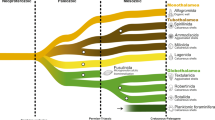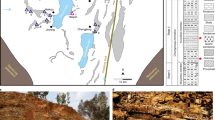Abstract
Planktonic foraminifers are some of the most widely used micro-fossils for dating marine sedimentary rocks and the calcareous test has been used to reconstruct their depositional history over the past 120 million years1. By tracing the successive growth stages of extant representatives of this group, we have obtained criteria which identify pre-adult forms that, traditionally, have been disregarded in foraminiferal research. Thus, large quantities of “… unidentifiable miscellaneous juveniles …”2 have become available to help decipher the fossil record of marine environments. Comparative studies of growth series at species and supraspecific levels allowed the identification of three major species groups, each showing three different developmental stages. Their recognition introduces new possibilities for establishing a natural classification of planktonic foraminifers, for disclosing their evolutionary history and for testing evolutionary models in general.
This is a preview of subscription content, access via your institution
Access options
Subscribe to this journal
Receive 51 print issues and online access
$199.00 per year
only $3.90 per issue
Buy this article
- Purchase on Springer Link
- Instant access to full article PDF
Prices may be subject to local taxes which are calculated during checkout
Similar content being viewed by others
References
Vincent, E. & Berger, W. H. in The Oceanic Lithosphere Vol. 7 (ed. Emiliani, C.) 1025–1119 (Wiley, New York, 1981).
Bé, A. W. H. & Hutson, W. H. Micropaleontology 23, 369–414 (1977).
Parker, F. L. Bull. Am. Palaeont. 52, 111–208 (1967).
Banner, F. T. & Blow, W. H. Micropaleontology 13, 133–162 (1967).
Olsson, R. K. Trans. Gulf Cst Ass. geol. Soc. 21, 419–432 (1971).
Olsson, R. K. Eclog. geol. Helv. 65, 185–195 (1972).
Parker, F. L. J. Foram. Res. 3, 70–77 (1973).
Parker, F. L. in Progress in Micropaleontology (eds Takayanagi, Y. & Saito, T.) 258–262 (Micropaleontology Press, New York, 1976).
Huang, C. Y. J. Foram. Res. 11, 173–190 (1981).
Stainforth, R. M., Lamb, J. L., Luterbacher, H., Beard, J. H. & Jeffords, R. M. Paleont. Contr. Univ. Kans. 62, 1–425 (1975).
Steineck, P. L. & Fleischer, R. L. J. Paleont. 52, 618–635 (1978).
Kennett, J. P. & Srinivasan, M. S. Neogene Planktonic Foraminifera (Hutchinson & Ross, Stroudsburg, 1983).
Gould, S. J. Ontogeny and Phylogeny (Harvard University Press, Cambridge, 1977).
Stanley, S. M. Macroevolution (Freeman, San Francisco, 1979).
Hedberg, H. D. (ed.) International Stratigraphie Guide (Wiley, New York, 1976).
Berger, W. H. Mar. Geol. 11, 325–358 (1971).
Author information
Authors and Affiliations
Rights and permissions
About this article
Cite this article
Brummer, GJ., Hemleben, C. & Spindler, M. Planktonic foraminiferal ontogeny and new perspectives for micropalaeontology. Nature 319, 50–52 (1986). https://doi.org/10.1038/319050a0
Received:
Accepted:
Issue Date:
DOI: https://doi.org/10.1038/319050a0
This article is cited by
-
The daily resolved temperature dependence and structure of planktonic foraminifera blooms
Scientific Reports (2020)
-
Surface ocean metabarcoding confirms limited diversity in planktonic foraminifera but reveals unknown hyper-abundant lineages
Scientific Reports (2018)
-
Distribution patterns of micro- and meso-zooplankton communities in sea ice regions of Lützow-Holm Bay, East Antarctica
Polar Biology (2013)
-
Modern planktic foraminifera
Paläontologische Zeitschrift (2005)
-
Fossil planktic foraminifera (an overview)
Paläontologische Zeitschrift (2005)
Comments
By submitting a comment you agree to abide by our Terms and Community Guidelines. If you find something abusive or that does not comply with our terms or guidelines please flag it as inappropriate.



